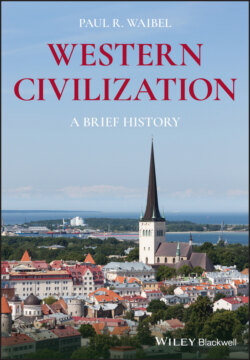Читать книгу Western Civilization - Paul R. Waibel - Страница 57
Europe's Neighbors The Byzantine Empire
ОглавлениеIn the year 330, Constantine moved the capital of the Roman Empire to the East. He chose the site of Byzantium, a Greek colony founded in c. 667 bc. It was a strategically important location on the European side of the Strait of Bosporus that connects the Mediterranean Sea with the Black Sea. The city overlooked the Sea of Marmora and the Bosporus. On the northern side was the Golden Horn, an excellent harbor.
Rome ceased to be the capital of the empire when Diocletian created the Tetrarchy in 293. The Tetrarchy provided for four administrative centers, or capitals, but the economic and political center of the empire was increasingly in the East. The eastern provinces of the empire – Asia Minor, Syria, and Egypt – were the wealthiest part of the empire. There, were found the most prosperous cities with a vibrant urban culture. There was also an abundant labor supply, and productive agriculture, especially in Asia Minor.
Constantine named his new capital simply “New Rome.” After his death in 337, the city was known as Constantinople in his honor, and remained so until 1923. Greek was the popular language and Latin the official language. It was not until the middle of the eighth century, when the Byzantine Empire was reduced to Greek‐speaking Asia Minor, the Balkans, and a portion of southern Italy, that the empire became culturally Greek. Justinian (c. 482–565) was the last emperor to use the title “Caesar.” By 750, the emperor's official title was “king” (basileus) and Greek was the official language.
Justinian was the greatest of the Byzantine emperors, the one most responsible for the image we have today of the Byzantine Empire. He became emperor after the death of his uncle, Justin I (450–527), an illiterate peasant and swineherd who rose to become Commander of the Palace Guard. Justin became emperor when Anastasius I died in 518. In April, 527, just four months before his death, Justin named Justinian, who was already co‐emperor, his successor. This soldier of humble origins became one of the most historically important figures of late antiquity and the early Middle Ages.
Justinian tried to reunite the old Roman Empire. With his armies under the command of Belisarius (500–565), a brilliant military commander who ranks along with Julius Caesar, Alexander the Great, and Napoleon Bonaparte, Justinian won back most of Italy, eastern Spain, and the coastline of North Africa, but at a great price. What remained of Roman civilization in Italy after the fall of the empire in the West was destroyed in the struggle between the Goths and Belisarius' army. The necessary taxes to finance the conquest in the West and the wars with Persia in the East placed stress on the empire's resources and caused unrest among the populace. Almost all of the reconquered territories were lost after Justinian's death. Only in southern Italy did the Byzantine Empire remain in control into the eleventh century. It was from southern Italy and Sicily that the Byzantine culture exerted a lasting influence on the development of European civilization.
Justinian's greatest achievement was the Corpus Iuris Civilis (“Body of Civil Law”), the first comprehensive compilation and codification of Roman law. The task began in 527, when Justinian ascended the throne, and was not complete until 565, the year of Justinian's death. Its impact was felt well beyond the Byzantine Empire. The revived interest in Roman law at the new European universities during the tenth century, especially the University of Bologna in Italy, led to it becoming the basis of the Roman Catholic Church's canon law. It eventually became a major influence in most of the world's legal systems.
Justinian took a deep interest in Christianity, which he saw as a major support for the state. Unlike the Roman Catholic Church in the West that fought for the independence of the church from secular control, the Patriarch of the Orthodox Church was subordinate to the emperor. Religious conformity was enforced. Heretics were prosecuted. “It is right that those who do not worship God correctly,” said Justinian, “should be deprived of worldly advantage too” (Galli and Olsen 2000, p. 313). Justinian closed the Academy in Athens in 529; he regarded it as a center of pagan learning.
Next to the Corpus Iuris Civilis, Justinian's greatest achievement was the construction of the Hagia Sophia, Church of Holy Wisdom, in Constantinople. Justinian was a great builder who constructed churches throughout the empire during his 38‐year reign. Construction began in February, 532, and the cathedral was inaugurated by the emperor and the patriarch on December 27, 537. Until the construction of St. Peter's Basilica in Rome between 1506 and 1626, it was the largest and most spectacular church in the world. In Europe, it was often referred to simply as “the Church.” A Roman Catholic cleric who visited the Hagia Sophia said that when he entered the church, it was as if he entered heaven.
It was in the Byzantine East that classical, Christian, and oriental cultures synthesized. The Byzantine Empire was a continuation of the urban based civilization of the Hellenistic and Roman eras. To these, was added the increasingly important cultural influences of the revived Persian (Sassanian) Empire. While Europe was going through its “Dark Ages” during the fifth through ninth centuries, the resources of the ancient world, especially Greek literature and Roman law, were preserved in the Byzantine Empire until they could be reintroduced to Europe during the High Middle Ages and the Renaissance. Also, until the fall of Constantinople in 1453 to the Ottoman Turks, the Byzantine Empire guarded the eastern frontier of Europe from the conquering armies of Islam.
